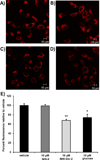Dual targeting of the Warburg effect with a glucose-conjugated lactate dehydrogenase inhibitor
- PMID: 24174263
- PMCID: PMC3919968
- DOI: 10.1002/cbic.201300562
Dual targeting of the Warburg effect with a glucose-conjugated lactate dehydrogenase inhibitor
Abstract
Effective glucose diet: We report the development and activity of glucose-conjugated LDH-A inhibitors designed for dual targeting of the Warburg effect (elevated glucose uptake and glycolysis) in cancer cells. Glycoconjugation could be applied to inhibitors of many enzymes involved in glycolysis or tumor metabolism.
Keywords: Warburg effect; cancer; drug design; glycoconjugation; targeted anticancer agents.
Copyright © 2013 WILEY-VCH Verlag GmbH & Co. KGaA, Weinheim.
Figures




Similar articles
-
Identification of a potent inhibitor targeting human lactate dehydrogenase A and its metabolic modulation for cancer cell line.Bioorg Med Chem Lett. 2016 Jan 1;26(1):72-5. doi: 10.1016/j.bmcl.2015.11.025. Epub 2015 Nov 10. Bioorg Med Chem Lett. 2016. PMID: 26597536
-
Discovery of N-hydroxyindole-based inhibitors of human lactate dehydrogenase isoform A (LDH-A) as starvation agents against cancer cells.J Med Chem. 2011 Mar 24;54(6):1599-612. doi: 10.1021/jm101007q. Epub 2011 Feb 18. J Med Chem. 2011. PMID: 21332213
-
When will small molecule lactate dehydrogenase inhibitors realize their potential in the cancer clinic?Future Med Chem. 2017 Jul;9(11):1113-1115. doi: 10.4155/fmc-2017-0082. Epub 2017 Jul 19. Future Med Chem. 2017. PMID: 28722474 No abstract available.
-
Targeting cancer metabolism to develop human lactate dehydrogenase (hLDH)5 inhibitors.Drug Discov Today. 2018 Jul;23(7):1407-1415. doi: 10.1016/j.drudis.2018.05.014. Epub 2018 May 8. Drug Discov Today. 2018. PMID: 29750903 Review.
-
Recent Update on Human Lactate Dehydrogenase Enzyme 5 (hLDH5) Inhibitors: A Promising Approach for Cancer Chemotherapy.J Med Chem. 2016 Jan 28;59(2):487-96. doi: 10.1021/acs.jmedchem.5b00168. Epub 2015 Sep 4. J Med Chem. 2016. PMID: 26340601 Review.
Cited by
-
Reactive Oxygen Species Synergize To Potently and Selectively Induce Cancer Cell Death.ACS Chem Biol. 2017 May 19;12(5):1416-1424. doi: 10.1021/acschembio.7b00015. Epub 2017 Apr 7. ACS Chem Biol. 2017. PMID: 28345875 Free PMC article.
-
Recent Advances in Biosensing With Photonic Crystal Surfaces: A Review.IEEE Sens J. 2016 May 15;16(10):3349-3366. doi: 10.1109/JSEN.2015.2429738. Epub 2015 May 5. IEEE Sens J. 2016. PMID: 27642265 Free PMC article.
-
Targeting Energy Metabolism in Cancer Treatment.Int J Mol Sci. 2022 May 16;23(10):5572. doi: 10.3390/ijms23105572. Int J Mol Sci. 2022. PMID: 35628385 Free PMC article. Review.
-
Emerging concepts of T cell metabolism as a target of immunotherapy.Nat Immunol. 2016 Apr;17(4):364-8. doi: 10.1038/ni.3415. Nat Immunol. 2016. PMID: 27002844 Free PMC article.
-
Extrinsic and Intrinsic Immunometabolism Converge: Perspectives on Future Research and Therapeutic Development for Obesity.Curr Obes Rep. 2019 Sep;8(3):210-219. doi: 10.1007/s13679-019-00344-2. Curr Obes Rep. 2019. PMID: 30919312 Free PMC article. Review.
References
-
- Warburg O. Science. 1956;123:309–314. - PubMed
-
- Chan DA, Sutphin PD, Nguyen P, Turcotte S, Lai EW, Banh A, Reynolds GE, Chi JT, Wu J, Solow-Cordero DE, Bonnet M, Flanagan JU, Bouley DM, Graves EE, Denny WA, Hay MP, Giaccia AJ. Sci Transl Med. 2011;3:94ra70. - PMC - PubMed
- Luo F, Liu X, Yan N, Li S, Cao G, Cheng Q, Xia Q, Wang H. BMC Cancer. 2006;6:26. - PMC - PubMed
-
- Altenberg B, Greulich KO. Genomics. 2004;84:1014–1020. - PubMed
-
- Bensinger SJ, Christofk HR. Semin Cell Dev Biol. 2012;23:352–361. - PubMed
Publication types
MeSH terms
Substances
Grants and funding
LinkOut - more resources
Full Text Sources
Other Literature Sources
Miscellaneous

